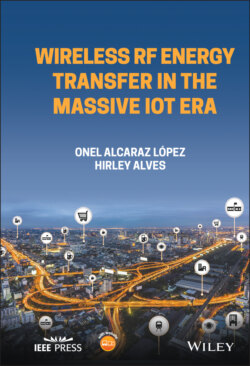Читать книгу Wireless RF Energy Transfer in the Massive IoT Era - Hirley Alves - Страница 4
Contents
Оглавление1 Cover
2 Title page
3 Copyright
4 Preface
5 Acknowledgments
6 Acronyms
7 Mathematical Notation
8 About the Companion Website
9 1 Massive IoT1.1 Selected Use-cases and Scenarios1.2 Key Technologies1.3 Requirements and KPIs1.4 Key Enablers1.4.1 Holistic and Globally Scalable Massive IoT1.4.2 Sustainable Connectivity1.5 Final Remarks and Discussions
10 2 Wireless RF Energy Transfer: An Overview2.1 Energy Harvesting2.1.1 EH Sources2.1.2 RF Energy Transfer2.2 RF–EH Performance2.2.1 Analytical Models2.2.2 State-of-the-art on RF EH2.3 RF–EH IoT2.3.1 Architectures of IoT RF EH Networks2.3.2 Green WET2.3.3 WIT-WET Layouts2.3.4 RF EH in IoT Use Cases2.4 Enabling Efficient RF-WET2.4.1 Energy Beamforming2.4.2 CSI-limited Schemes2.4.3 Distributed Antenna System2.4.4 Enhancements in Hardware and Medium2.4.5 New Spectrum Opportunities2.4.6 Resource Scheduling and Optimization2.4.7 Distributed Ledger Technology2.5 Final Remarks
11 3 Ambient RF EH3.1 Motivation and Overview3.1.1 Hybrid of RF–EH and Power Grid3.1.2 Energy Usage Protocols3.1.3 On Efficient Ambient RF–RH Designs3.2 Measurement Campaigns3.2.1 Greater London (2012)3.2.2 Diyarbakir (2014)3.2.3 Flanders (2017-2019)3.2.4 Other Measurements3.3 Energy Arrival Modeling3.3.1 Based on Arbitrary Distributions3.3.2 Based on Stochastic Geometry3.4 A Stochastic Geometry-based Study3.4.1 System Model and Assumptions3.4.2 Energy Coverage Probability3.4.3 Average Harvested Energy3.4.4 Meta-distribution of Harvested Energy3.4.5 Numerical Results3.5 Final Considerations
12 4 Efficient Schemes for WET4.1 EH from Dedicated WET4.2 Energy Beamforming4.2.1 Low-complexity EB Design4.2.2 CSI-limited Energy Beamforming4.2.3 Performance Analysis4.3 CSI-free Multi-antenna Techniques4.3.1 System Model and Assumptions4.3.2 Positioning-agnostic CSI-free WET4.3.3 Positioning-aware CSI-free WET4.4 On the Massive WET Performance4.5 Final Considerations
13 5 Multi-PB Massive WET5.1 On the PBs Deployment5.1.1 Positioning-aware Deployments5.1.2 Positioning-agnostic Deployments5.2 Multi-antenna Energy Beamforming5.2.1 Centralized Energy Beamforming5.2.2 Distributed Energy Beamforming5.2.3 Available RF Energy5.3 Distributed CSI-free WET5.3.1 SA, AA–IS and RPS–EMW5.3.2 AA–SS5.3.3 RAB5.3.4 Positioning-aware CSI-free Schemes5.3.5 Numerical Examples5.4 On the Deployment Costs5.5 Final Remarks
14 6 Wireless-powered Communication Networks6.1 WPCN Models6.2 Reliable Single-user WPCN6.2.1 Harvest-then-transmit (HTT)6.2.2 Allowing Energy Accumulation6.2.3 HTT versus FEIPC6.3 Multi-user Resource Allocation6.3.1 Signal Model6.3.2 Problem Formulation6.3.3 Optimization Framework6.3.4 TDMA versus SDMA6.4 Cognitive MAC6.4.1 Time Sharing and Scheduling6.4.2 MAC Protocol at the Device Side6.4.3 MAC Protocol at the HAP Side6.5 Final Remarks
15 7 Simultaneous Wireless Information and Power Transfer7.1 SWIPT Schemes7.2 Separate EH and ID Receivers7.2.1 Problem Formulation7.2.2 Optimal Solution7.2.3 Performance Results7.3 Co-located EH and ID Receivers7.3.1 Time Switching7.3.2 Power splitting7.3.3 TS versus PS7.4 Enablers for Efficient SWIPT7.4.1 Waveform Optimization7.4.2 Multicarrier SWIPT7.4.3 Cooperative Relaying7.4.4 Interference Exploitation7.4.5 Artificial Intelligence7.5 Final Considerations
16 8 Final Notes8.1 Summary8.2 Future Research Directions
17 A A Brief Overview on Finite Block Length CodingA.1 Finite Block Length Model
18 B Distribution of Transferred RF Energy Under CSI-free WETB.1 Proof of Theorem 4.2B.2 Proof of Theorem 4.4
19 C Clustering AlgorithmsC.1 Partitioning MethodsC.1.1 K-MeansC.1.2 K-MedoidsC.1.3 K-ModesC.2 Hierarchical MethodsC.3 Other MethodsC.4 Pre-processing
20 D Required SNR for a Target Decoding Error Probability (Proof of Theorem 6.1)D.1 On the Convergence of Algorithm 3
21 Bibliography
22 Index
23 End User License Agreement
